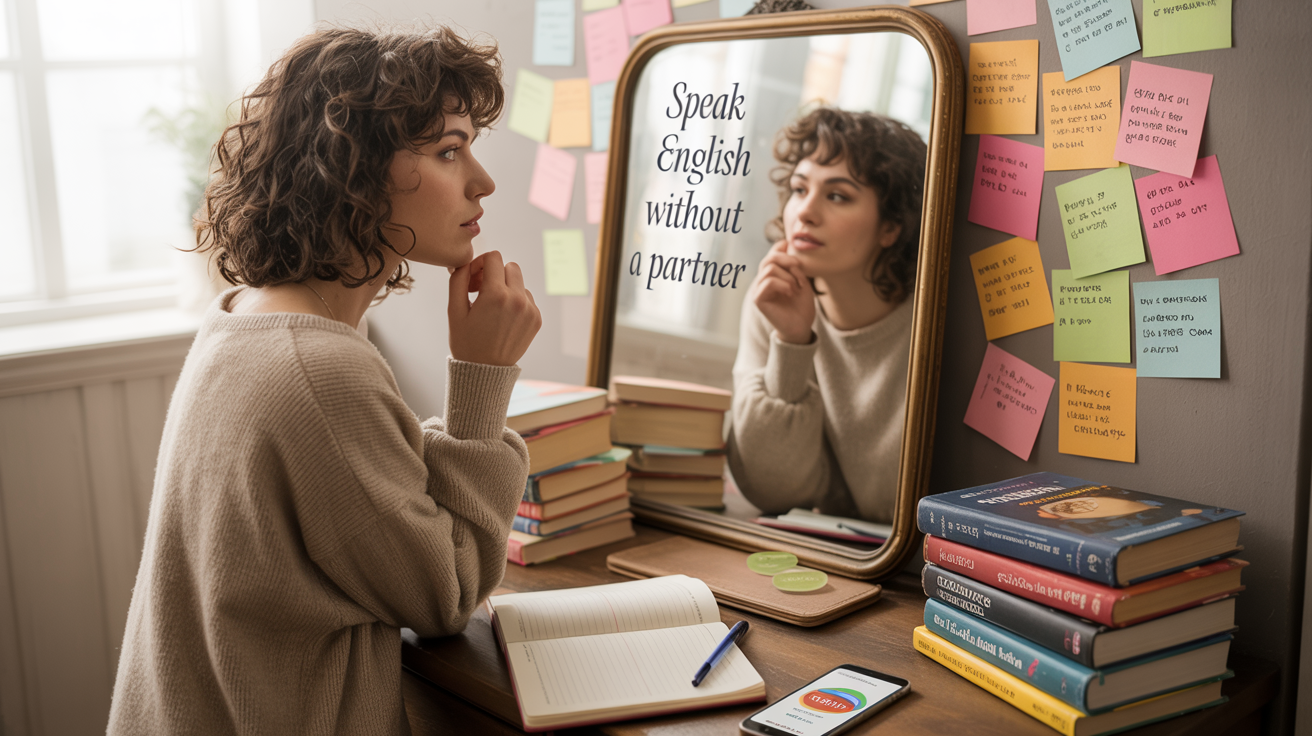Why I Wanted to Learn English
When I was a teenager, I always dreamed of traveling the world. I wanted to visit new countries, meet people, and learn about different cultures. But every time I thought about it, one thing stopped me—English. Most people in the world speak English, and I didn’t. I knew I had to learn it.
Later, when I started looking for jobs, I saw that many good jobs needed English skills. Even in my own country, companies wanted people who could speak English. I felt like I was missing so many chances. I had the skills, but I didn’t have the language.
I also remember feeling left out with my friends. Some of them could speak English well. They watched Hollywood movies without subtitles. They laughed at jokes I didn’t understand. When we met tourists, they could talk to them—but I stayed quiet. I felt small, like I didn’t belong.
One day, I tried to talk to a tourist in my city. I wanted to help her find the museum. But when I opened my mouth, the words just didn’t come out. I knew what I wanted to say, but I couldn’t say it. I felt so embarrassed. That moment stayed in my heart for a long time.
I went home that day and told myself, “This can’t happen again.” I didn’t want to feel helpless anymore. I wanted to speak English with confidence. I wanted to understand movies, talk to new people, and feel proud of myself.
Learning English wasn’t just about a job or school for me. It became something personal. I wanted to change how I saw myself. I wanted to become stronger, more open, more connected to the world. And English felt like the key.
But the truth was, I didn’t have a teacher. I didn’t have a partner to practice with. I didn’t have money for a course. All I had was my dream and my room. That’s when I started thinking—what if I could practice by myself?
That question changed everything for me. And in the next chapter, I’ll tell you how I felt when I had no one to talk to—and what I decided to do next.
I Had No One to Practice With
After I decided to learn English, I started with great energy. I watched YouTube videos, listened to podcasts, and read easy English books. But something was missing—speaking. I wasn’t using my mouth. I wasn’t speaking the language, only hearing it.
I looked around, but I didn’t have any English-speaking friends. No one in my family spoke English either. At school, we studied grammar, but we didn’t talk. We wrote sentences and filled in blanks. That wasn’t real speaking.
I tried using language apps. Some of them were helpful, and I did learn new words. But they didn’t help me speak with confidence. The speaking parts were too short. And talking to a computer didn’t feel real. I still felt alone.
There were days when I would open my mouth to speak, but nothing came out. I was scared of making mistakes. My pronunciation was bad, and I felt stupid. So, I just stayed quiet. I knew the words in my head, but they never came out in time.
I remember one evening, I sat in my room, listening to an English movie. I could understand it, but I thought, “When will I speak like that?” It felt impossible. I felt stuck, like I was on a road with no direction. I had the desire, but not the method.
Some people told me, “Just find a partner.” But where? I didn’t live in a big city. I didn’t know anyone online. I didn’t feel confident enough to talk to strangers. So, I stayed silent and waited. But deep inside, I knew that waiting wouldn’t help me grow.
Then one night, a small idea came to my mind. I thought, “If I have no one to speak with—maybe I can speak to myself.” It sounded strange, but it gave me hope. In the next chapter, I’ll tell you how this simple idea became my first real step to speaking English.
The Idea That Changed Everything
One evening, I was sitting alone in my room, thinking about my English. I had studied so much, but I still couldn’t speak. I felt lost. But then, a small, strange idea came to my mind. I thought, “What if I try to speak English… to myself?”
At first, it felt funny. Why would I talk to myself? People might think I’m crazy! But I remembered something—children learn to speak by talking, even when no one answers. So, I said to myself, “Let’s try it. No one is watching.”
I stood in front of the mirror and looked at myself. I said, “Hello, my name is Ben. I want to speak English.” My voice was slow and quiet. I laughed a little because it felt so silly. But at the same time, I felt proud. I had started.
The next day, I took it one step further. I started talking to my phone. I turned on the camera and recorded myself. I spoke about simple things—what I ate for lunch, how I felt, what I planned to do. Then I watched the videos. I saw my face, heard my voice, and corrected my mistakes.
I also used a notebook. I wrote short sentences in English, then read them aloud. Sometimes I even talked to objects in my room. “This is my chair. I sit on it. It is brown.” It was simple, but it helped me learn new words and feel more confident.
With time, speaking alone didn’t feel strange anymore. It became a habit. I started enjoying it. I felt free, because there was no one to judge me. I could make mistakes, laugh at myself, and try again. Slowly, I started to trust myself.
That one small idea—speaking to myself—was the key. It turned my silent learning into real practice. And in the next chapter, I’ll tell you about the biggest thing that helped me grow—talking to my mirror every day.
My First Home Routine
Once I realized I could speak English to myself, I decided to build a small routine. I wanted something simple I could do every day. It didn’t need to be perfect. It just needed to help me speak more and feel less afraid. I called it my “home routine.”
First, I started with the mirror. Every morning, I stood in front of it and looked at myself. I smiled and said, “Good morning, Ben. How are you today?” Then I answered, “I’m good, thank you.” I tried to make eye contact with myself, like I was talking to a real person.
Then I began to describe what I was doing. I would say things like, “Now I’m brushing my teeth,” or “I am making tea.” If I didn’t know a word, I wrote it down and searched it later. This helped me learn new vocabulary and use it in my real life.
Another thing I loved doing was watching YouTube videos in English. I didn’t just listen—I copied the lines. When someone said something interesting or funny, I paused the video and repeated the line with the same tone. Sometimes, I said it five or six times until it felt natural.
After that, I created simple questions and answered them. I would ask, “What did you eat for breakfast?” and answer, “I ate eggs and toast.” Then, “What’s your plan today?” and I’d reply, “I’m going to study English and clean my room.” This helped me think in English.
At first, this routine took 10 to 15 minutes a day. But over time, I wanted to do more. I started doing it twice a day—once in the morning and once before bed. It felt like a workout for my mouth and brain. I was training my English muscles.
What made this routine work was how personal it felt. I wasn’t copying someone else’s method. I was creating my own way to practice. I used my words, my life, my time. No pressure, no fear—just me and my English.
In the next chapter, I’ll tell you about how I started to feel real progress. Small changes in my speaking made me feel proud and excited—and I knew I was on the right path.
I Started to Feel a Change
After a few weeks of speaking to myself every day, I started to notice something amazing—I was changing. At first, the changes were small. I could say more words without stopping. I didn’t feel so nervous when I spoke. I even started thinking in English sometimes.
One day, I watched a short video on YouTube. I paused it and repeated the sentences. To my surprise, I understood everything. I smiled. I felt proud. I was growing.
My voice became stronger. At first, I was shy and quiet. But now, when I spoke in front of the mirror, I looked into my own eyes and said the words with power. I wasn’t afraid of making mistakes anymore. I started to enjoy the sound of my own English.
One of the biggest changes came when I met a tourist in my city. She looked lost, so I asked, “Can I help you?” She smiled and said, “Yes, please.” We talked for five minutes. I helped her find her way. It wasn’t perfect, but it was real. And it worked.
I went home that day and cried a little—not because I was sad, but because I was proud. I had spoken English with a real person. I had helped someone. My hard work was paying off. I felt strong, like I had a new superpower.
My confidence started to grow. I joined an online English group. I didn’t speak at first, but I listened. Then one day, I said one sentence. The people in the group smiled and said, “Good job!” That small support made a big difference.
Speaking English was no longer a dream. It was becoming my reality. I knew I still had a long way to go, but I had already come so far. I wasn’t the same person I used to be.
In the next chapter, I’ll tell you about the funny moments, the mistakes I made, and how I learned to laugh at myself instead of feeling bad.
Funny Mistakes I Made
Learning to speak English at home was not always easy. In fact, it was often very funny. I made so many mistakes—but now, when I look back, those mistakes make me smile.
One time, I wanted to say “I’m full” after dinner, but I said “I’m fool.” My cousin laughed so hard. I was a little embarrassed, but I laughed too. That day, I learned the difference between “full” and “fool” very clearly!
Another time, I was practicing in front of the mirror and said, “I love cooking my family and my dog.” I didn’t notice the missing commas. It sounded like I was cooking them! Later, I learned that commas can save lives.
There was also a day when I tried to copy a sentence from a movie. The actor said it so fast. I repeated it loudly, and my neighbor thought I was fighting with someone. He knocked on my door and asked if everything was okay. I had to explain I was just practicing English!
I even tried singing English songs, but I said all the wrong lyrics. I thought I was singing well, but when I looked up the real words later, I was shocked. Still, it was fun—and I learned a lot of new words through music.
Sometimes I would talk to myself while walking. People looked at me like I was crazy. But I didn’t care. I was practicing. I was learning. I was getting better every day.
The truth is, mistakes are part of learning. They are not the enemy—they are your best teachers. Every time I made a mistake, I remembered the lesson more clearly.
In the next chapter, I’ll share how my self-practice helped me talk to real people with confidence—and how it changed my life in amazing ways.
Speaking to Real People
After many weeks of speaking to myself, something amazing happened—I started speaking to real people.
The first time was with a tourist, as I told you before. But after that, I looked for more chances to speak. I joined a free English-speaking club online. I was nervous, but I remembered all my practice. I turned on my microphone and said, “Hi, my name is…” and it felt natural.
The other people in the group were kind. Some were better than me, and some were just starting like I was. We helped each other. We laughed together. We made mistakes together. And we grew together.
I also started helping tourists in my city. When I saw someone who looked lost, I walked up and said, “Do you need help?” At first, my voice shook a little, but I still spoke. Every conversation made me stronger.
One day, a tourist asked me about the best places to eat. I explained everything in English. He said, “Your English is good!” That small sentence felt like a big reward. It made me want to keep learning.
I started talking to people online—on apps, in groups, even in games. I wasn’t afraid anymore. I knew I could do it because I had practiced so much at home, alone, in front of the mirror.
Speaking English was not just a dream now. It was real. I could connect with people from around the world. I could share my thoughts, ask questions, tell stories. English gave me a bigger world.
You Can Do It Too
If you are reading this and feel shy, scared, or think you can’t speak English—let me tell you something: you can. I was like you. I was shy. I had no one to practice with. But I found a way. I practiced with myself. I spoke in front of the mirror. I made my own English world at home.
You don’t need to wait for the perfect teacher, school, or partner. You have everything you need—your voice, your mirror, your phone. Use them. Speak. Make mistakes. Laugh. Learn. Grow.
The mirror will not judge you. Your voice will become stronger. And slowly, step by step, you will change. Just like I did.
Remember, learning a language is not about being perfect. It’s about trying every day. It’s about not giving up. It’s about speaking, even when you feel afraid.
So go to your mirror today. Say “Hello, my name is…” Speak to yourself. Speak every day. Speak with love, with hope, with power.
You can do it. I believe in you.
And one day, you will speak to the world with confidence and pride.
The end.




